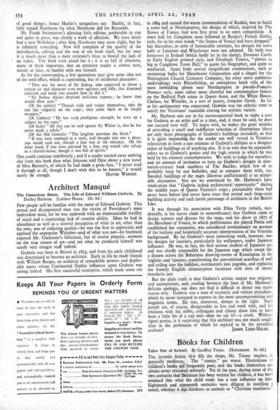Boswell Redivivus ?
WHEN, in 1826, Hazlitt published, in The New Monthly Magazine, a series of articles consisting of his talks with Northcote, the title given to them was "Boswell Redivivus." The reason needs now some enquiry. "He looks like a rat who has seen a cat," said a contemporary of Northcote. He was small, frugal in his habits ; his house dirty and neglected. Why, therefore, should anyone, least of all Hazlitt, not merely take trouble to converse with him, but think the talks important ?
Proof of the pudding is in the eating. Moreover, part of the answer is that Hazlitt started out •himself as a painter, and retained his interest in the fine arts. The late P. P. Howe missed little about him, but one of the few items lacking from his list of Hazlitt's known paintings, at any rate in one current reprint of his standard Life, is a portrait of Patrick Kelly, LL.D., still to be seen at the Foundling Hospital Gallery in Brunswick Square. Everyone knows his version of Lamb, now at tbo National Portrait Gallery ; both works are interesting and in fact, had he stuck to his easel, he might well have become a—Northcote.
Northcote was Reynolds' pupil, though he says Sir Joshua taught him little. He wrote a life which has always been used-as a quarry for Reynolds material, and he could sometimes paint well. For instance, his " Admiral Viscount Hood," now at Greenwich, is a work of which Reynolds himself need not have been ashamed. But he was one of those people who are remembered better for what they were than for what they did. He lived to be eighty-five (1746-1831), and had known most people in the artistic and literary world of his time. It was a time when to be an R.A. meant membership of a very lively body of people. His memory retained a rare proportion
of good things ; hence Hazlitt's scrupulous ear. Hazlitt, in fact, fully repaid Northcote for what Northcote did for Reynolds. Mr. Frank Swinnerton's pleasing little edition, pocketable in size and quiet in price, was clearly a work of affection. We have lately had a new Nollekens ; after him, NorthcOte may seem slight, but he is infinitely rewarding. Few Will complain of the quality of the introduction, editing and the text of the book itself, but for once it is much more than a mere reviewer's bleat to bewail the lack of • an index. The book cries aloud for it ; it is so full of allusions, many of them important, that an attentive reader is almost sure, sooner or later, to fumble with one himself.
As for the conversation, a few quotations may give some idea not of the total effect, which is captivating, but of incidental pleasures : , "That was the merit of Sir Joshua, who contrived to throw a certain air and character even over ugliness and folly, that disarmed criticism and made you wonder how he did it."
" Sir Joshua always despised malicious reports ; he knew they would blow over."
(Of the gallery) " Though rude and vulgar themselves, they do not like vulgarity on the stage ; they come theie to be taught manners."
(Of Cobbeu) " He has surly_ prodigious strength, he tears up a subject by the roots."
(Of Scott) " All that can be said against Sir Walter is, that he has never made a whole."
(Of the Old Comedy) " The laughter prevents the blush."
" If you were confined in a vault, and thought you saw a ghost, you would rush out, though a lion was at the entrance. On the other hand, if you were pursued by a lion, you would take refuge in a charnel-house, though it was full of spirits."
One could continue indefinitely ; and if a reader carried away nothing • else from this book than what Johnson told Opie about a new novel of Miss Burney's, of which he had made a great fuss, " I never read it through at all, though I don't wish this to be known," it would



































 Previous page
Previous page